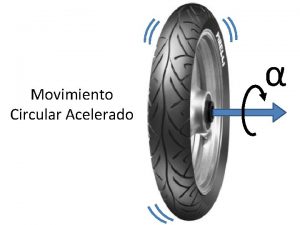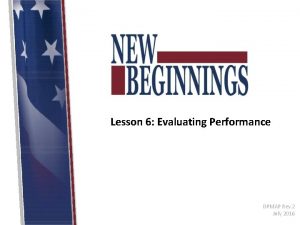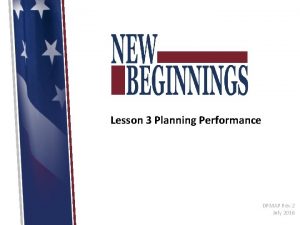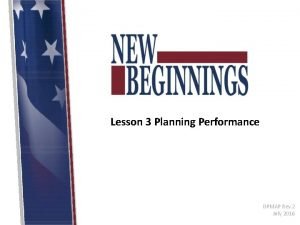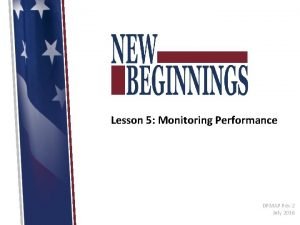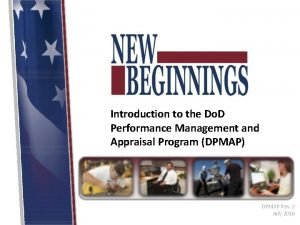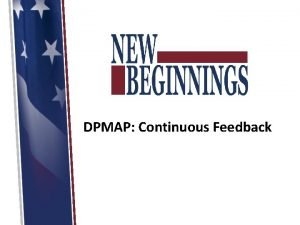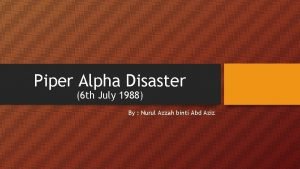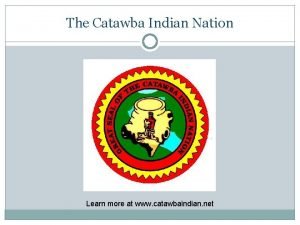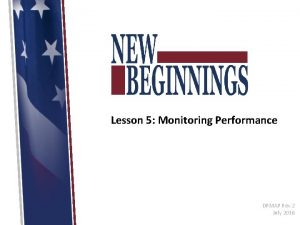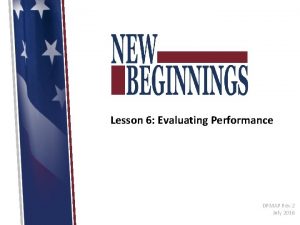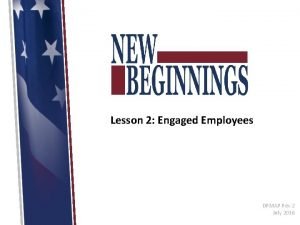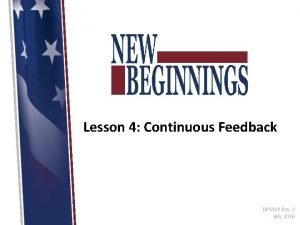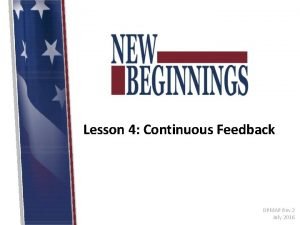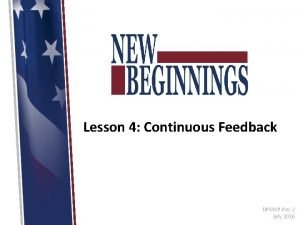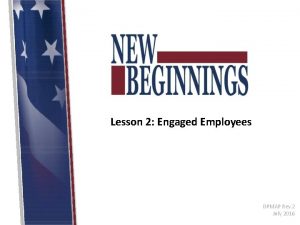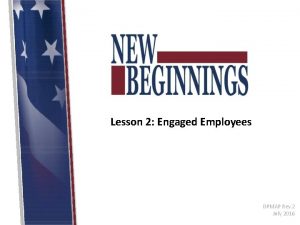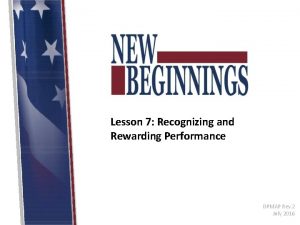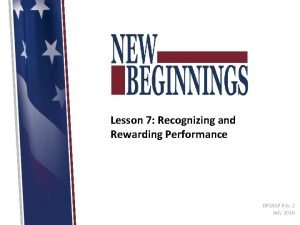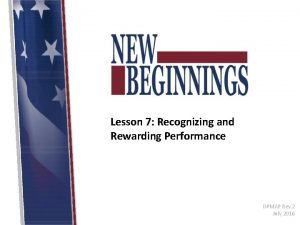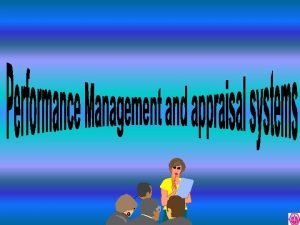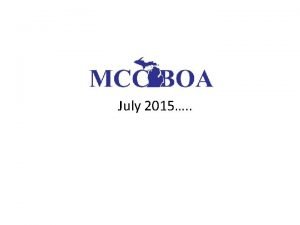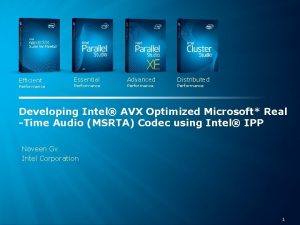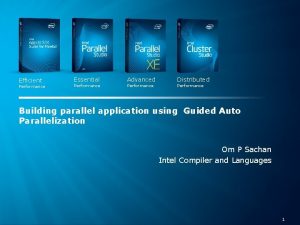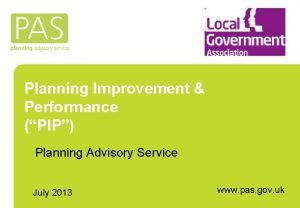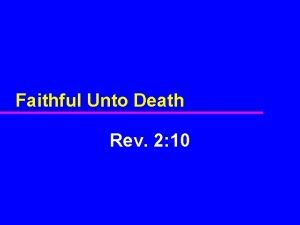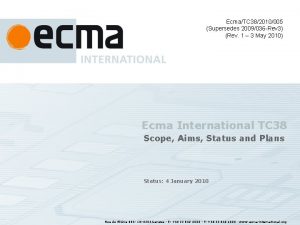Lesson 3 Planning Performance DPMAP Rev 2 July

































- Slides: 33

Lesson 3 Planning Performance DPMAP Rev. 2 July 2016

Performance Management is a COLLABORATIVE EFFORT between Supervisors and Employees DPMAP Rev. 2 July 2016 (2)

Learning Objectives Upon completion of this lesson, you will be able to: – Explain the performance planning phase and its importance to the success of the performance management process. – Explain how to link your work performance plan to your organization’s mission and core values. – Write performance standards for the performance plan using the SMART concept. – Describe tools and techniques used to finalize the performance plan. Performance Management is a COLLABORATIVE EFFORT between Supervisors and Employees DPMAP Rev. 2 July 2016 (3)

Performance Management Ongoing Supervisors and employees share responsibility Consist of: Proactively planning work and setting expectations Continually monitoring performance Evaluating performance in a summary fashion Recognizing and rewarding good performance PLANNING EVALUATING PERFORMANCE MANAGEMENT MONITORING RECOGNIZING AND REWARDING Performance Management is a COLLABORATIVE EFFORT between Supervisors and Employees DPMAP Rev. 2 July 2016 (4)

The Importance of Planning Plan work, set expectations for future results Connect employee’s work to the Do. D mission and how it cascades down to the employee Increase awareness of expectations and results Provide a sense of ownership in the plan Create a better understanding of performance and evaluation standards Performance Management is a COLLABORATIVE EFFORT between Supervisors and Employees DPMAP Rev. 2 July 2016 (5)

Planning Performance Planning Phase Effective performance planning is a result of employee and supervisor engagement that provides opportunity for employee input in establishing ongoing communication and establishment of a mutual understanding of performance expectations and organizational goals throughout the performance appraisal cycle Performance Management is a COLLABORATIVE EFFORT between Supervisors and Employees DPMAP Rev. 2 July 2016 (6)

Planning Phase Roles and Responsibilities Employees: • • • Supervisors: Identify achievable performance elements and standards for themselves • Compile list of tasks • Establish appropriate performance elements Provide input to supervisor regarding the performance plan • Establish quantifiable and measureable standards • Communicate approved performance plan to employee and how performance expectations link to organizational goals • Encourage continuous, meaningful two-way communication • Proactively communicate the plan to the employee • Provide a copy of the approved performance plan • Conduct performance planning discussion s • Modify the performance plan, as needed Ask questions to clarify the supervisor’s expectations of their performance Performance Management is a COLLABORATIVE EFFORT between Supervisors and Employees DPMAP Rev. 2 July 2016 (7)

Performance Elements Performance elements describe what work is to be performed Performance plans must have a minimum of one critical performance element, maximum of 10, and each performance element must have associated standards that define expectations The number of supervisory performance elements on performance plans for supervisors will equal or exceed the number of nonsupervisory (technical) performance elements An organization may have standardized performance elements Do. D Instruction 1400. 25, Vol. 431 Performance Management is a COLLABORATIVE EFFORT between Supervisors and Employees DPMAP Rev. 2 July 2016 (8)

Standards describe how the requirements and expectations provided in the performance elements are to be evaluated Should be written using SMART criteria Must be written at “Fully Successful” level for each performance element Avoid using absolute standards (e. g. , 100 percent, always, or never) unless critical to life and safety Do. D Instruction 1400. 25, Vol. 431 Performance Management is a COLLABORATIVE EFFORT between Supervisors and Employees DPMAP Rev. 2 July 2016 (9)

Are the standards applicable? Can the supervisor use the standards to appraise performance? The standards should clearly describe the factors that the supervisor would look for and how well those factors should be done. Standards should specify: • • Quality Quantity Timeliness Cost-effectiveness Can the supervisor effectively use the data collected? • If monitoring performance on the performance element is too costly or time-consuming, the standard might need to be altered to include more manageable standards Performance Management is a COLLABORATIVE EFFORT between Supervisors and Employees DPMAP Rev. 2 July 2016 (10

Are the standards achievable? Are expectations reasonable? Research has shown that setting expectations that are impossible or nearly impossible to achieve can actually cause performance levels to drop because employees tend to give up if they perceive the goal as impossible Performance Management is a COLLABORATIVE EFFORT between Supervisors and Employees DPMAP Rev. 2 July 2016 (11)

Are the standards fair? Are they comparable to expectations for other employees in similar positions? – Applying different standards to employees doing the same work does not appear on its face to be fair or valid – Requiring higher-level management review of standards for similar work across an organization may be one way of ensuring equity Do the standards allow for some margin of error? – Requiring perfection is not fair in most instances Performance Management is a COLLABORATIVE EFFORT between Supervisors and Employees DPMAP Rev. 2 July 2016 (12)

Can the Fully-Successful be surpassed? Is it possible for an employee's performance to exceed the standard? By including “Fully Successful” standards that cannot be surpassed, the performance plan effectively eliminates the opportunity for the employee to obtain a higher assessment Performance Management is a COLLABORATIVE EFFORT between Supervisors and Employees DPMAP Rev. 2 July 2016 (13)

Are performance elements and standards adjustable? Can they be adapted readily to changes in resources? Performance elements and standards can be modified during the performance appraisal cycle to meet changing organizational goals and other situations – As long as the employee works under the new standards for at least 90 days This flexibility allows performance plans to be used as management tools to manage employee performance on a day-to-day and week-to-week basis Performance Management is a COLLABORATIVE EFFORT between Supervisors and Employees DPMAP Rev. 2 July 2016 (14)

Writing SMART Standards S M Measurable A Achievable R Relevant T Timely Specific Performance Management is a COLLABORATIVE EFFORT between Supervisors and Employees DPMAP Rev. 2 July 2016 (15)

Writing SMART Standards S Specific: stated as simply, concisely, and explicitly as possible. • Defined as specific behaviors, efficiencies, or results • Concrete and job-related • Stated in active voice with one action verb Example: Type written communications for the division. Performance Management is a COLLABORATIVE EFFORT between Supervisors and Employees DPMAP Rev. 2 July 2016 (16)

Writing SMART Standards M Measurable: Outcome-oriented, reflecting the most important aspects of performance Should be able to • Evaluate objectively • Identify criteria for success and failure • Provide a number or percent that can be tracked Example: Type written communications for the division with less than 3 errors per page. Performance Management is a COLLABORATIVE EFFORT between Supervisors and Employees DPMAP Rev. 2 July 2016 (17)

Writing SMART Standards A Achievable: Can be accomplished with available resources Should be: • Realistic requirements • Appropriate amount of work/responsibility • Feasible according to the employee’s competencies and the organization’s resources Example: Type written communications for the division according to the unit’s established guidelines with no more than 3 errors per page. Performance Management is a COLLABORATIVE EFFORT between Supervisors and Employees DPMAP Rev. 2 July 2016 (18)

Writing SMART Standards R Relevant: the standard is important to the employee and the organization. Should be: • Consistent with the employee’s role in the workplace. • Aligned with the employee’s skills, knowledge, and ability needed to reach fully successful • Made clear to employee that task is important to success of the organization Performance Management is a COLLABORATIVE EFFORT between Supervisors and Employees DPMAP Rev. 2 July 2016 (19)

Writing SMART Standards T Timely: Change within acceptable timeframe Should be: • State when task should be completed. • Express as a clear and unambiguous timeframe. • Plausible according to average workload. Example: Type written communications for the division according to the unit’s established guidelines, with no more than 3 errors per page and no less than 80% completed on time. Performance Management is a COLLABORATIVE EFFORT between Supervisors and Employees DPMAP Rev. 2 July 2016 (20)

Example 1: SMART Standards Timely 1. Provide relevant, timely, all-source intelligence reporting Complete analysis of effects of UN-imposed sanctions on Iraqi industrial sector and present results in appropriately coordinated intelligence report for release to policy-making Specific community by 31 August. Product will reflect engagement with other analysts and stakeholders, and incorporate their Relevant coordinated views. The completed product will make use of available intelligence from at least 90% of relevant sources as dictated by ICD 203. 2 and reflect engagement with other Measurable/ stakeholders in the subject of the analysis. Achievable Performance Management is a COLLABORATIVE EFFORT between Supervisors and Employees DPMAP Rev. 2 July 2016 (22)

Example 2: SMART Standards Timely 2. Provide accurate, timely customer service Upon receipt of requests, provide accurate responses in the agreed-upon timeframes, as defined by ICD 24. 8, using the appropriate format identified in SOP 25 during the performance appraisal cycle ending March 31, 2017. This supports the organization’s commitment to be responsive to customers and clients. Meet suspenses 90% of the time. Provide accurate responses with no more than 2 errors per request. Specific Relevant Measurable/ Achievable Performance Management is a COLLABORATIVE EFFORT between Supervisors and Employees DPMAP Rev. 2 July 2016 (23)

Performance Plans Performance Plan All of the written, or otherwise recorded, performance elements and standards that set expected performance. The plan must include critical performance elements and their standards. Each employee must have a written performance plan established and approved normally with 30 calendar days of start of the performance appraisal cycle, or employee’s assignment to a new position or set of duties. Do. D Instruction 1400. 25, Vol. 431 Performance Management is a COLLABORATIVE EFFORT between Supervisors and Employees DPMAP Rev. 2 July 2016 (24)

Will employees understand what is required? If the standards are generic, have they been supplemented with specific information so that employees know what they have to do to demonstrate “Fully Successful” performance? Performance elements and their standards should be written clearly and be specific to the job Performance Management is a COLLABORATIVE EFFORT between Supervisors and Employees DPMAP Rev. 2 July 2016 (26)

Is the Fully Successful performance level clearly understood by the supervisor and employee? Are the expectations established in the performance elements and standards quantifiable, observable, and/or verifiable? Expectations that are specific and that clearly define what must be done and how well it must be done are more effective for managing and directing performance than vague or general expectations Employees must know what they have to do and how well they have to do it to perform at a Fully Successful level Performance Management is a COLLABORATIVE EFFORT between Supervisors and Employees DPMAP Rev. 2 July 2016 (27)

Revising the Performance Plan A change to the Performance Plan may be needed if there: Are there new organizational goals Is a change in assignment(s), position, or duties Are outside influences beyond an employee’s control that make the original performance elements unachievable Is a change in assumptions about what can be reasonably achieved during the performance appraisal cycle Are new priorities Are shifts or changes in mission Minimum 90 calendar days for: • monitoring of approved performance plans • employee performance of new performance elements Do. D Instruction 1400. 25, Vol. 431 Performance Management is a COLLABORATIVE EFFORT between Supervisors and Employees DPMAP Rev. 2 July 2016 (28)

Finalize Performance Plan After discussion(s), finalize a written performance plan It’s important that both the supervisor and the employee understand the performance plan, even if not in agreement Plans must be clearly communicated to and acknowledged by employees Performance Management is a COLLABORATIVE EFFORT between Supervisors and Employees DPMAP Rev. 2 July 2016 (29)

Performance Plan Checklist When developing a performance plan, ask: Is the Fully Successful performance level clearly understood by supervisor and employee Are the standards achievable? Are the standards fair? Are the standards applicable? Will employees understand what is required? Are the performance elements and standards adjustable? Can the “Fully Successful” level be surpassed? Performance Management is a COLLABORATIVE EFFORT between Supervisors and Employees DPMAP Rev. 2 July 2016 (30)

Benefits of the Performance Plan Checklist Using the performance plan checklist and involving employees allows for: • A better understanding of what is expected • An understanding of the terminology used • An understanding of how performance will be measured • Acceptance and trust in the process Performance Management is a COLLABORATIVE EFFORT between Supervisors and Employees DPMAP Rev. 2 July 2016 (31)

Planning the Meeting With the Employee Communicate how performance elements and standards relate back to organizational goals Ask for feedback on the performance elements and standards performance elements Organizational Goals Standards Performance Management is a COLLABORATIVE EFFORT between Supervisors and Employees DPMAP Rev. 2 July 2016 (33

Learning Objectives Review You should now be able to: – Explain the performance planning phase and its importance to the success of the performance management process. – Explain how to link your work performance plan to your organization’s mission and core values. – Write performance standards for the performance plan using the SMART concept. – Describe tools and techniques used to finalize the performance plan. Performance Management is a COLLABORATIVE EFFORT between Supervisors and Employees DPMAP Rev. 2 July 2016 (35)

Questions? Are there any questions? Performance Management is a COLLABORATION between Supervisors and Employees DPMAP Rev. 2 July 2016 (36)

Additional Resources DODI 1400. 25, Volume 410, Do. D Civilian Personnel Management System: Training, Education, and Professional Development. DODI 1400. 25, Volume 431, Do. D Civilian Personnel Management System: Performance Management and Appraisal Program. DODI 1400. 25, Volume 451, Do. D Civilian Personnel Management System: Awards A Handbook for Measuring Employee Performance: Aligning Employee Performance Plans with Organizational Goals. Available at: https: //www. opm. gov/policy-data oversight/performancemanagement/measuring/employee_performance_handbook. pdf DCPAS Resources and References web site includes: DCPAS HR Toolkit, Tip Sheets and Checklist, My. Performance Training Videos, and My. Performance User Guides https: //www. cpms. osd. mil/Subpage/New. Beginnings/Resources. References/ DCPAS LERD web site https: //dodhrinfo. cpms. osd. mil/Directorates/HROPS/Labor-and-Employee. Relations/Pages/Home 1. aspx Performance Management is a COLLABORATIVE EFFORT between Supervisors and Employees DPMAP Rev. 2 July 2016 (37)
 Movimiento circular uniforme formulas
Movimiento circular uniforme formulas Outstanding dpmap employee input examples
Outstanding dpmap employee input examples Dpmap performance elements narrative examples
Dpmap performance elements narrative examples Dpmap smart examples
Dpmap smart examples Performance appraisal dpmap employee input examples
Performance appraisal dpmap employee input examples Dpmap examples employee input
Dpmap examples employee input Dpmap
Dpmap Dpmap
Dpmap Missing in venice harris burdick
Missing in venice harris burdick Missing in venice harris burdick
Missing in venice harris burdick July 1-4 1863
July 1-4 1863 Gcc july 2020
Gcc july 2020 Astronomy picture of the day 11 july 2001
Astronomy picture of the day 11 july 2001 2001 july 15
2001 july 15 2003 july 17
2003 july 17 July 30 2009 nasa
July 30 2009 nasa Sources nso july frenchhowell neill technology...
Sources nso july frenchhowell neill technology... What is the significance of july 4 1776 brainpop
What is the significance of july 4 1776 brainpop I am silver and exact i have no preconceptions
I am silver and exact i have no preconceptions The cuban melodrama
The cuban melodrama Poppies in july imagery
Poppies in july imagery July 10 1856
July 10 1856 Ctdssmap payment schedule july 2021
Ctdssmap payment schedule july 2021 July 1969
July 1969 6th july 1988
6th july 1988 Monday 13th july
Monday 13th july On july 18 2001 a train carrying hazardous chemicals
On july 18 2001 a train carrying hazardous chemicals July 4 sermon
July 4 sermon June too soon july stand by
June too soon july stand by July 2 1937 amelia earhart
July 2 1937 amelia earhart June 22 to july 22
June 22 to july 22 July 12 1776
July 12 1776 The hot july sun beat relentlessly down
The hot july sun beat relentlessly down Super saturday tribal bingo july 4
Super saturday tribal bingo july 4
